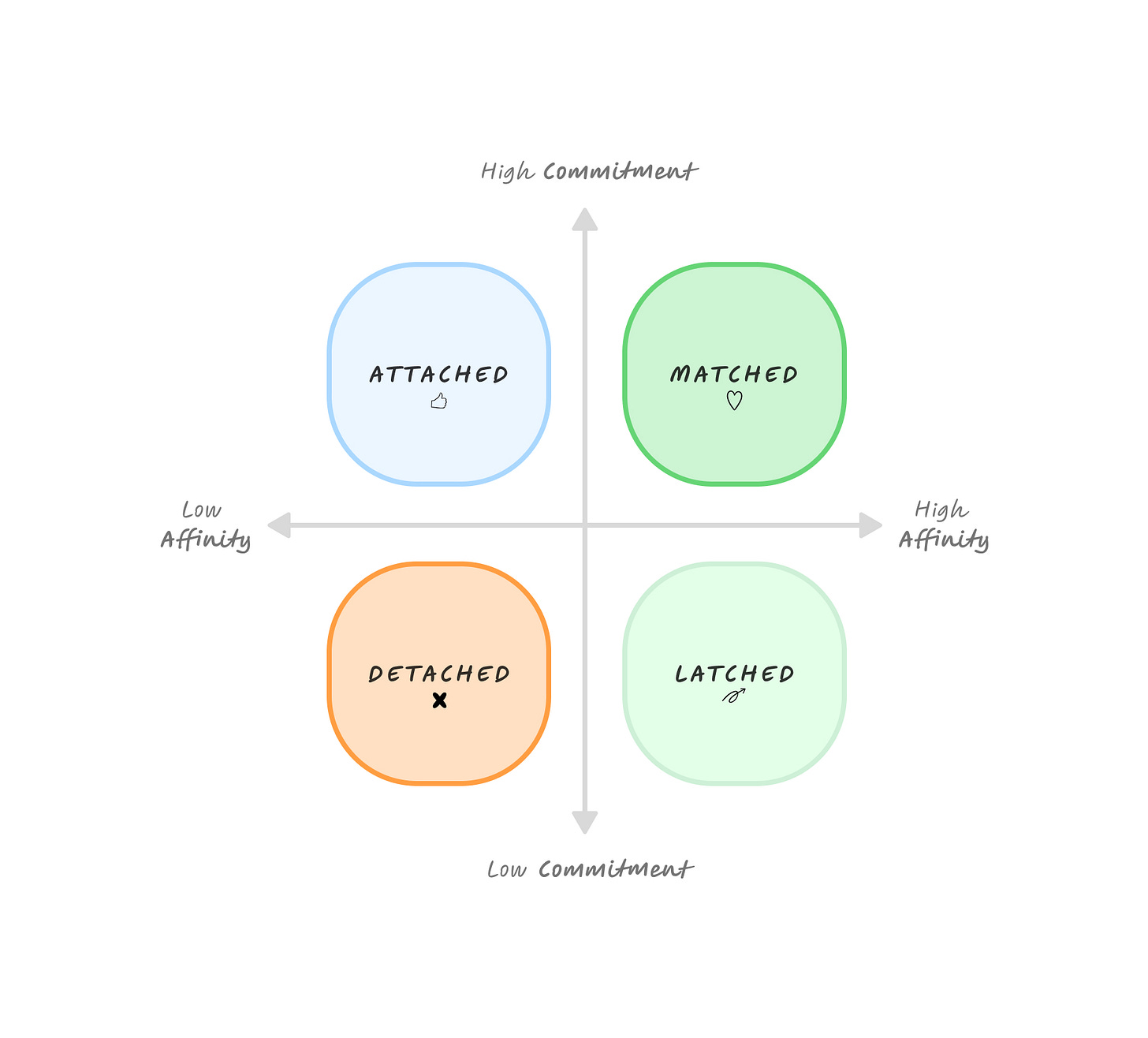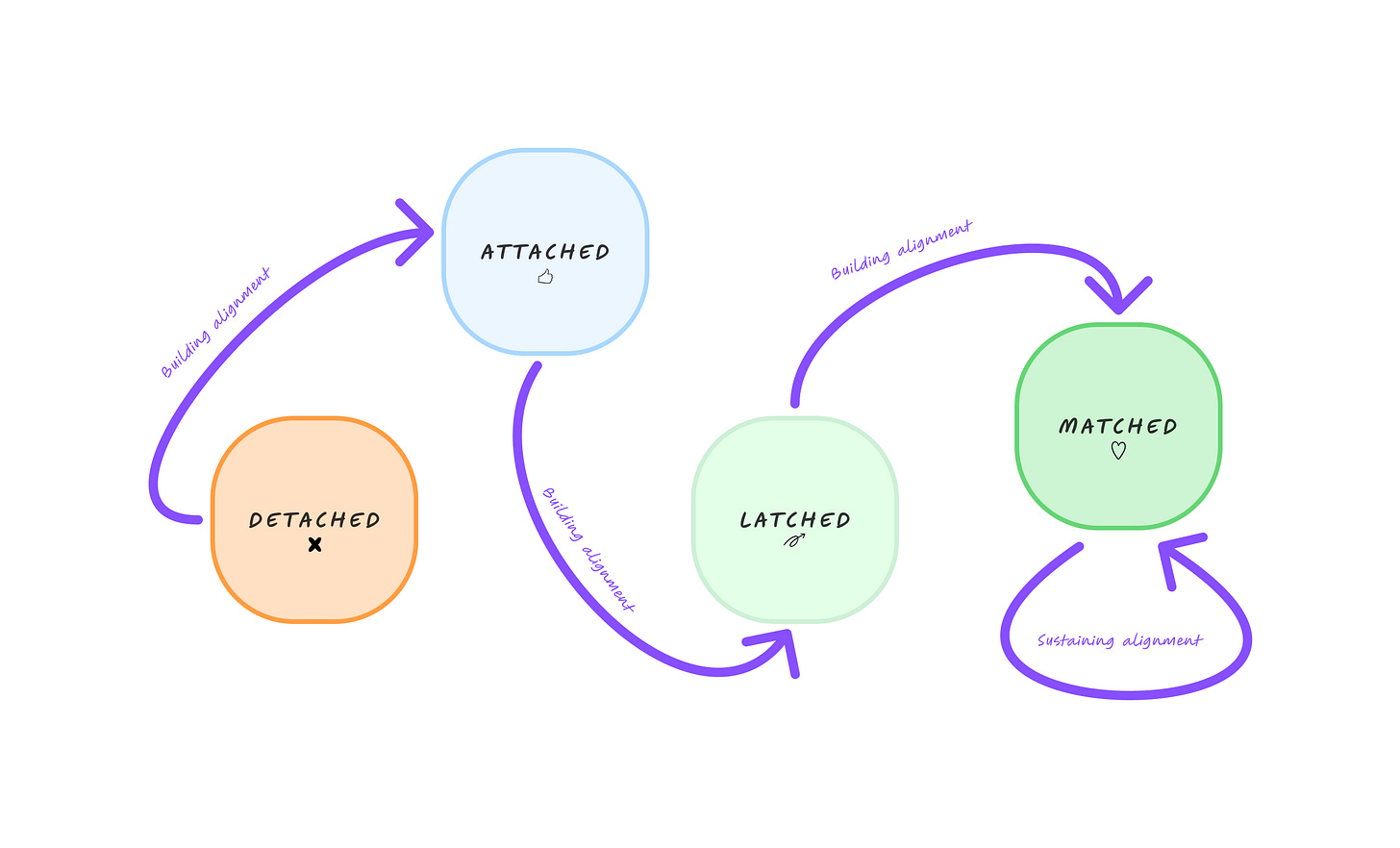Beyond binary, the four faces of alignment
I believe the ability to build alignment at multiple levels on a product direction is a core PM skill.
To me, this statement is obvious and non-controversial. It is hard to envision the PM role without this core skill. But in recent times, I’ve observed an emerging idea that the hard work of building broad-based, durable alignment on product direction is possibly a bug, more than a feature. I’ve seen this idea echoed in a few places - whether it be execs or leaders feeling like “Founder Mode” (h/t Paul Graham) gives them a pass on getting buy-in from different parts of the organization for big decisions, or PMs who misinterpret the thrust behind “Empowered Product Teams” (h/t Marty Cagan) as an entitlement to autonomously make product decisions (and expect others around them to fall in line) or a growing trend of people seeing alignment-building as a tax on the org, that is necessarily slow and expensive.
I can empathize with the fact that there is sometimes value in top-down decisions cutting through the noise of a busy, dynamic org. Or situations where a PM must drive clarity in the context of a complex decision with tradeoffs, and make the final call (not to be re-litigated perpetually). Or the idea that consensus-building can be a major drag sometimes, especially for larger teams. But none of this makes me fully empathize for these modes being the default M.O. for them to operate with. And I recommend PMs and product leaders look at building alignment as both a capability to build and an asset to possess - even if they don’t have to use it to make progress.
If you are here, it is likely that you would agree that (a) alignment-building is important and (b) it should be seen as a core PM skill or leadership trait. In the past, I have touched on this broader theme from a few different angles, ex:
Today’s essay will come at a similar theme, but from a higher-level: how may we understand & diagnose our level of alignment in the first place? Let’s explore.
Alignment is not just one thing
Many of our typical conversations about alignment assume it is straightforward and binary in nature -
“Are we aligned?” [note only one answer possible: yes or no]
“I’m not aligned to this decision” [uh-oh, here we go again]
“We’re ready to go. All stakeholders are aligned with the proposal” [congratulations! but also, are you sure about that?]
In reality, alignment is never as simple as either present vs. absent, or strong vs. weak even. In product work, you can boil alignment down to two dimensions -
Level of Affinity
Affinity is about the degree of conviction, enthusiasm and emotional or intellectual resonance the other person has for the direction/decision/strategy at play. Affinity is inherently personal and organic in nature. It stems from their personal motivations, beliefs and perspectives. As a PM, you can absolutely influence the degree to which there is natural affinity from the other side - but it is not fully within your control. It is about them.
Level of Commitment
Commitment is about the degree of intent, investment and action the other person is willing to take in service of the direction/decision/strategy at play. Commitment is still about the individual, but it is not necessarily personal in nature. The level of commitment you get from the other person can be influenced by their broader job expectations, other responsibilities or burdens that take away from their ability to commit to your mutual area, operational constraints they operate under, etc. As a PM, you can both expect a certain degree of commitment from others and influence it too.
Putting two and two together
Alignment = Affinity + Commitment
Alignment is a two-dimensional equation. Understanding that helps us better understand how aligned our team-mates, stakeholders, partners and leaders actually are to our product direction.
Matched: the folks who are as bought-in as can be. They have a high level of natural affinity to the product direction being worked on, and a strong sense of ownership and buy-in to act on it. These are your co-authors, co-conspirators, allies and champions who will help you succeed because they share in your beliefs and the success of it.
Latched: the folks who naturally and intrinsically believe in the value of the direction you are working towards, but are struggling to fully commit to it. These are the people who want to believe, but won’t (or can’t) take a blind leap of faith to commit themselves fully to making it happen. These are your collaborators and advocates too, but not quite equal partners in the journey (yet). Their engagement can feel like a latch-lock on a door (flimsy, but enough to do the job) more so than a strong deadbolt lock.
Attached: the folks who don’t have natural conviction or personal belief in the product direction, but will nonetheless do what they can or need to, to give it a good shot of succeeding. They can be positive collaborators and even supporters from the sidelines - but are less likely to be the ones to proactively invest themselves into the direction. They are attached to the direction, but loosely - perhaps like velcro!
Detached: these are folks who are both low on affinity and commitment in the product direction. Often their lack of affinity comes from a place of believing in a different strategy or alternative direction - and that feeds directly into their lack of willingness or ability to act on the one you are proposing. They are detached, and generally prefer it that way.
This two-dimensional view helps us understand a few common wisdoms you may have heard before, things like “alignment is not the same as agreement” (since agreement is about affinity, which is part of alignment, but not the whole) or “disagree-and-commit” (which is a call to action for teams to not just stay in a detached state, but to at least attach themselves to the chosen direction, even if they have less affinity to it).
What does “being good at building alignment” really mean?
In an ideal, perfect world - we would have perfect matches in terms of alignment, at every level of the organization and across all functions. Deep affinity and high commitment - all greens, all the time! [that does sound wonderful, doesn’t it?] In a less perfect world, we tend to look for shortcuts: wouldn’t it be nice if everyone around us committed, even if they disagreed? [that sounds far less wonderful, but at least easier!]
But when I think of the building alignment as a core PM skill, my mind goes to a different place - neither so ideal, nor so easy. Building alignment is about figuring out how to move everyone necessary around you to their next quadrant of commitment or affinity - no matter where they start. It is about finding strategies to create attachment for those who are detached, to help the attached feel like they want to also latch themselves onto your direction, to build commitment for those who are latched so they can feel deeply matched, and then sustaining a high degree of alignment for the best matches - the core group - in perpetuity. Until you succeed.
This approach is more like a fluid system of alignment-building, as opposed to a utopian vision of achieving universal alignment, or a compromised appetite for a ‘cheat code’ to get more of the team & org behind you. Approaching it systematically like this allows you to be intentional when working through a number of common alignment challenges along the way, ex:
A cross-functional partner who is latched may need more evidence or proof-points from the execution of the strategy to become a full match.
When assembling a new team or initiative, you need to ensure a high density of matched folks out-the-gate, with strong affinity and commitment, especially at the leadership levels. They are the core.
In the face of a detached team-member or stakeholder, you can seek out productive commitment first, instead of feeling disheartened by their lack of affinity.
You are less likely to fall prey to a situation where colleagues are overtly or officially aligned on paper (i.e. attached), but their motivation is not intrinsic in nature - yet. A pattern I refer to sometimes as shallow alignment, and one you can mitigate by continuing to work with them to build more affinity.
Realizing that even if you have a strong group of matches, you need to continue to sustain it over time. As priorities change or pivots are required or new learnings come through, it requires continuous work to nurture deep alignment.
Start small
If this concept resonates, try this experiment:
The next time someone says “great, we’re aligned” or “I'm not aligned to this” - pause and ask yourself - is this about affinity or commitment? What am I seeing on the surface vs. what I might need to read-between-the-lines to understand? What quadrant are they in, and where do I need them to be right now? And finally - what's one thing I can do right now to help them get there?



